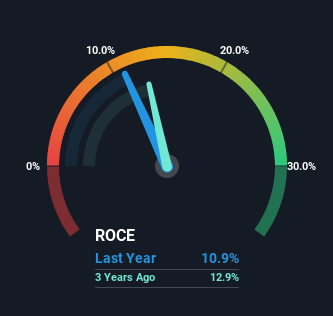The Returns At Stingray Group (TSE:RAY.A) Aren't Growing
If we want to find a stock that could multiply over the long term, what are the underlying trends we should look for? In a perfect world, we'd like to see a company investing more capital into its business and ideally the returns earned from that capital are also increasing. Put simply, these types of businesses are compounding machines, meaning they are continually reinvesting their earnings at ever-higher rates of return. So, when we ran our eye over Stingray Group's (TSE:RAY.A) trend of ROCE, we liked what we saw.
What Is Return On Capital Employed (ROCE)?
For those who don't know, ROCE is a measure of a company's yearly pre-tax profit (its return), relative to the capital employed in the business. To calculate this metric for Stingray Group, this is the formula:
Return on Capital Employed = Earnings Before Interest and Tax (EBIT) ÷ (Total Assets - Current Liabilities)
0.11 = CA$85m ÷ (CA$876m - CA$95m) (Based on the trailing twelve months to September 2023).
Therefore, Stingray Group has an ROCE of 11%. On its own, that's a standard return, however it's much better than the 8.3% generated by the Media industry.
Check out our latest analysis for Stingray Group
In the above chart we have measured Stingray Group's prior ROCE against its prior performance, but the future is arguably more important. If you'd like to see what analysts are forecasting going forward, you should check out our free report for Stingray Group.
So How Is Stingray Group's ROCE Trending?
While the returns on capital are good, they haven't moved much. The company has employed 302% more capital in the last five years, and the returns on that capital have remained stable at 11%. Since 11% is a moderate ROCE though, it's good to see a business can continue to reinvest at these decent rates of return. Stable returns in this ballpark can be unexciting, but if they can be maintained over the long run, they often provide nice rewards to shareholders.
One more thing to note, even though ROCE has remained relatively flat over the last five years, the reduction in current liabilities to 11% of total assets, is good to see from a business owner's perspective. This can eliminate some of the risks inherent in the operations because the business has less outstanding obligations to their suppliers and or short-term creditors than they did previously.
What We Can Learn From Stingray Group's ROCE
To sum it up, Stingray Group has simply been reinvesting capital steadily, at those decent rates of return. However, over the last five years, the stock hasn't provided much growth to shareholders in the way of total returns. For that reason, savvy investors might want to look further into this company in case it's a prime investment.
One more thing, we've spotted 2 warning signs facing Stingray Group that you might find interesting.
If you want to search for solid companies with great earnings, check out this free list of companies with good balance sheets and impressive returns on equity.
Have feedback on this article? Concerned about the content? Get in touch with us directly. Alternatively, email editorial-team (at) simplywallst.com.
This article by Simply Wall St is general in nature. We provide commentary based on historical data and analyst forecasts only using an unbiased methodology and our articles are not intended to be financial advice. It does not constitute a recommendation to buy or sell any stock, and does not take account of your objectives, or your financial situation. We aim to bring you long-term focused analysis driven by fundamental data. Note that our analysis may not factor in the latest price-sensitive company announcements or qualitative material. Simply Wall St has no position in any stocks mentioned.

